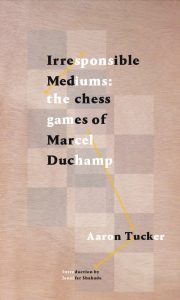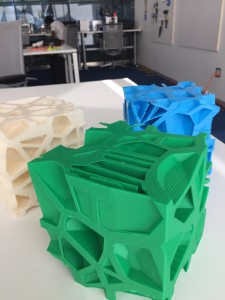Aaron Tucker’s digital art practice is grounded in a digital humanities that focuses primarily in machine translation and critical making. His digital works have been shown internationally, including in Brazil, Norway and Portugal, as well as across North America.
The ChessBard (chesspoetry.com)
 The ChessBard inputs the algebraic notation for a chess game in .PGN format (digital file format for archived chess games) and the ChessBard outputs a poem. The poems are based on 12 source poems Aaron wrote, 6 poems for the white pieces, 6 poems for the black pieces: there is a 64 word poem for each colour’s pawns, knights, rooks, bishop, queen and king. When a piece lands on a square it triggers a word from the source poems and the translator compiles them together and outputs a poem. At the site, yoau can upload an old game and have it translated at the translator page as well as play a game against the ChessBard and have that game translated into poems as you play.
The ChessBard inputs the algebraic notation for a chess game in .PGN format (digital file format for archived chess games) and the ChessBard outputs a poem. The poems are based on 12 source poems Aaron wrote, 6 poems for the white pieces, 6 poems for the black pieces: there is a 64 word poem for each colour’s pawns, knights, rooks, bishop, queen and king. When a piece lands on a square it triggers a word from the source poems and the translator compiles them together and outputs a poem. At the site, yoau can upload an old game and have it translated at the translator page as well as play a game against the ChessBard and have that game translated into poems as you play.

Aaron Tucker, Jordan Scott, Tiffany Cheung and Namir Ahmed
Loss Sets translates poems co-written by Jordan Scott and Aaron Tucker into sculptures printed with 3D printers. The project aims to respond to the multiples of loss (physical, environmental, artistic, personal) that occur in 2016 and, as such, the poems respond to a number of topics that include ISIS’s destruction of millennium-old artwork, the melting of Canadian ice fields and sculptures, the death of loved ones, prosthetics, decaying memories. The sculptures were then built in response to these losses and guided by concerns around the future of what 3D printing, as guided by a utopian, post-capital world in which any object can be made or replaced, will be conceived of and used for.
Related Digital Humanities Publications
“Addressing Machine Co-authorship(s) via Translative Creative Writing.” Journal of Creative Writing Studies.
Ed. Kathi Inman Berens. Summer 2019. URL.
“Beyond ‘Whiz-Bang’: 3D Printing and Critical Making in the Humanities”. Doing More Digital Humanities. Ed. C. Constance, R. Lane, and R. Siemens. Routledge. Fall, 2019. URL.
“Loss Sets: Project Snapshot.” Making Things and Drawing Boundaries: Experiments in the Digital Humanities Ed. Jentery Sayers. University of Minnesota Press, 2017. URL.